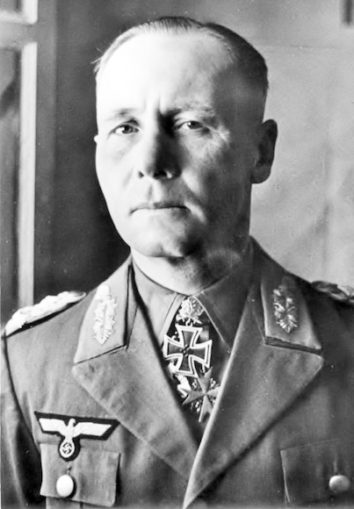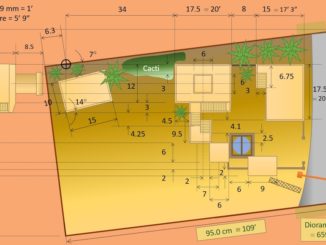The “Deutsches Afrikakorps” (DAK) were formed in 1941 after the failure of the Italian defence of their North African colonies against the British advance in Operation “Compass”. The Germans sent out the DAK, initially composed of the 5th Light Infantry Division and the 15th Panzer Division, with the intention of providing only a level of support sufficient to bolster the Italians and block any further British advance.
The DAK commander was General Erwin Rommel who had specific orders from the German High Command to limit any assistance given until all of his allocated forces were established on the ground in the Italian colony of Tripolitania. Rommel was also given by the Italian High Command, the control of their limited motorised forces still in existence but was also made by them to be subordinate to their General Rodolfo Graziani.

Field Marshal Erwin Rommel, c. 1942,
Bundesarchiv – Licence CC BY-SA 3.0
Johannes Erwin Eugen Rommel was born in 1891, his father was a teacher and his mother the daughter of a local government official. He joined the 124th Infantry Regiment in 1910 as an “aspirant” or Officer Cadet and ended WW1 having fought initially in France, winning the Eisernes Kreuz 2nd class, as a Kapitän decorated with the “Pour le Merit” for his leadership of actions on the Italian Front.
He remained in the reduced German army post WW1 and, as the new German Republic descended into Communist inspired civil strife into the 1920s, he personally led bloodless security actions to restore law and order in places like Frederikshavn and Lindau.
In the 1930s, Rommel was an instructor at the German War Academy when he authored his book on tactics, “Infanterie greift an” (Infantry Attacks), based on his WW1 experience, that had a considerable influence on the development of the Wehrmacht. Rommel was then assigned to being the liaison officer to the Hitler Youth but was subsequently removed from that post when tried to take it out of the control of the NSDAP and into that of the regular German army.
In 1938, he was seconded to command the Führerbegleitbrigade (Führer bodyguard) and in 1939 was promoted to Generalmajor. During this period Rommel in public apparently appeared to be ambivalent about the aims of the ruling NSDAP, his son Manfred saying that he “would look the other way” when confronted with anti-Jewish violence but in private he openly disagreed with the government’s antisemitism.
In 1939, following the invasion of Poland, Rommel was promoted to being the commander of a Panzer Division, ahead of more senior rivals, because of what was seen as his applicable use of surprise and manoeuvre in his WW1 command achievements that would suit tank warfare.
In 1940 he had successfully demonstrated his capabilities by fighting from the front with his Panzers across France to the Channel coast, the capture of the citadels of St Valery-en-Caux and of Cherbourg, and the surrender of over 12,000 soldiers including General Victor Fortune of the 51st Highland Division.
General Rodolfo Graziani on the other hand was an Italian noble and ardent Fascist known by the Arabs as the “Butcher of Fezzan” from his exploits in Libya from 1921 through to 1934 when he crushed the Senussi Rebellion (see Desert Mysteries – Part 1) and who had thousands of Ethiopians massacred in Addis Abba in 1937 when he was the Viceroy of Italian East Africa.
It was thus unsurprising that, given Graziani was the antithesis of the professional soldier, middle class and seemingly apolitical Rommel, that Rommel did not get on with Graziani and so did not directly inform him of his plans for the DAK.
After a parade in the Port of Tripoli on 15th February 1941 of only a small proportion of his force that had by then landed, the then Generalleutnant Rommel launched his offensive on the 18th, with a push forward of the 3rd Reconnaissance Regiment and the 39th Anti-tank Battalion. An unexpected offensive that surprised both the German and Italian High Commands as well as the British under General Alexander Wavell.
This eventually resulted in the thrusting back of the forces opposing the DAK out of Tripolitania and across the Italian colony of Cyrenaica to the port of Tobruk situated close to the Egyptian border. At the start of this offensive, Rommel had successfully requested that the Luftwaffe bomb Benghazi to disrupt the British supply lines, a task apparently declined by the Italian Air Force as many of their officers owned palatial homes there.
The DAK did not at any time have superiority over the opposing British in either numbers or firepower, but they had a commander who had already developed his theories of mobile warfare in practice during the Blitzkrieg across France and who led his men from the front, having the same food and water rations, and suffering the same privations and risks.
In particular, his tactically coordinated use of anti-tank guns and infantry supported by tanks overcame the sedentary British who, through outdated WW1 thinking and lack of effective training, failed to be able to use their infantry and tanks in conjunction with each other. Rommel apparently stated that, “Why should I bother about the superior number of British tanks when their commanders always use them in driblets? Against those driblets I am stronger with my army.”
Rommel would reconnoitre the terrain he would be attacking across either with his recon group or from the air (prior to the 18th of February he had flown in a Heinkel He111 over the approach his offensive would take), and then would set up the starting positions of his forces to gain the greatest advantage, usually that of surprise by appearing unexpectedly “out of the desert”.
At the beginning of an attack, usually after an artillery bombardment, it would be the DAK anti-tank guns covered by supporting Panzers that first moved forward and engaged the British tanks.
The British, in response, consistently failed to support their tanks adequately with infantry so that as soon as the anti-tank gunners had dealt with the tanks, the Panzers could then attack and overrun the British infantry positions and soft-skinned vehicles.
He would then “leapfrog” his forces so that as the Panzers were mopping up, the anti-tank gunners would quickly pass through them and move ahead to pursue the retreating British.
Frequently he outflanked the British which resulted in the capture of headquarters units such as that of Major-General Michael Gambier-Perry of the 2nd Armoured Division, Lieutenant-General Philip Neame, General Officer Commanding (GOC) Cyrenaica, and even that of Lieutenant-General Richard O’Connor, GOC British Troops in Egypt, who had been in charge of Operation Compass.
Rommel, by using almost all of his forces in mass attacks to repeatedly defeat the superior forces the British set against him, ended up with the DAK suffering overstretched supply lines due to their rapid advances.
However, the DAK took the opportunities to refuel and reequip in the field they were given by the British tendency to abandon their equipment, especially tanks, trucks, fuel and food stores, when attacked. Rommel is reputed to have told one of his officers, who had queried how they were to be supplied during an advance, to “take petrol hoses with them and get their fuel off the British”.
Eventually the majority of DAK supply trucks had inadvertently been provided by the British, the DAK fought in Beutepanzer platoons of captured British Matilda, Valentines and Crusaders tanks alongside their own Panzer II, III and IV. They ate captured British tinned foodstuffs, in particular the cases of Brazilian corned beef and those of “compo” ration packs of bully beef, spam, steak and kidney pudding, beans, cheese, jam, biscuits, soup, sausages, and margarine, unsurprisingly considered superior to the usual DAK diet of black bread, sardines and raw onions.
They even wore items from captured British clothing stocks with socks, pants and boots being particularly sought out as, along with shorts and great coats, their own were worn out and rarely could be replaced.
Unlike the British commanders who expected set-piece battles and thought that holding onto large areas of empty desert territory was important, Rommel, who compared desert warfare to a sea war and apparently said to his officers that “no admiral ever won a naval battle from a shore base,” concentrated on exploiting the rapid mobility of his mechanised forces along with the loyalty, flexibility, skill and resilience of his men whilst utilising the seemingly boundless open terrain of the desert to freely manoeuvre his forces.
Ultimately however, the DAK were defeated by being unable to replace their losses of men and armour due to the attrition of their supplies and supply routes by the RAF and RN aided by “Ultra” intercepts and code-breaking of German radio messages by a German High Command whose priorities were always elsewhere until it was too late. And finally, after Operation “Torch”, by having to fight simultaneously on two fronts, in the East and West, against Allied armies with now virtually limitless supplies, particularly armour, being shipped in from the burgeoning American military-industrial complex.
Rommel was not with his men when the last of them went into captivity, having been invalided back to Germany and been refused permission to return, but had Rommel’s first offensive passed Tobruk, crossed the Egyptian border and taken the Suez Canal, WW2 would have taken a completely different course.
Rommel was a hero to his men, seen as being “one of them” and was not only also admired by the troops he fought against but even Churchill praised him as “a great General” in the House of Commons. In post-war Germany, he was used as an example of a “good German” integration figure, especially as details of his involvement in the July 1944 plot and the events surrounding his death emerged.
However, as with all history, his reputation today and that of the Deutsches Afrikakorps are now being rewritten by “woke” revisionists who, rather than look at the military results they achieved, such as smashing the British 8th Army at Gazala and taking tens of thousands of prisoners, have decided that it was, in fact, all down to Dr Goebbels’ propaganda, that the DAK getting close to a decisive victory in North Africa was fantasy and Rommel was a Nazi who, had he survived, should have been tried for his supposed “war crimes” against Jews and Arabs.
The Bundeswehr, despite having two of its primary barracks (Generalfeldmarschall-Rommel-Kaserne in Augustdorf and Rommel-Kaserne in Dornstadt) named after him, the teaching of his tactics still taking place in military academies around the world, and even after the Bundesministerium der Verteidigung (German Ministry of Defence) announced in 2018 that Erwin Rommel would continue to be a “tradition-forming figure”, is under pressure that they should drop this so-called “hero worship”.
Instead, they should use a more modern-day example of a good German General of the Bundeswehr. Exactly who this would be is open to question, given the apparent lack of potential candidates.
As for General Rodolfo Graziani, post-war the Ethiopians wanted him charged with war crimes via the United Nations War Crimes Commission but, ironically, this was blocked by the British and, with the Americans being effectively ambivalent to any Italian wrongdoing, he ended up only on a charge of treason brought by the post-Mussolini Italian Republic. He was sentenced to 19 years in prison for “collaboration with the Nazis” but was released after only a few months on the grounds his actions were after he had “received orders”. He died in 1955 and, in 2012, a large new mausoleum was built over his grave in Affile in Rome.
© John Tull 2024



